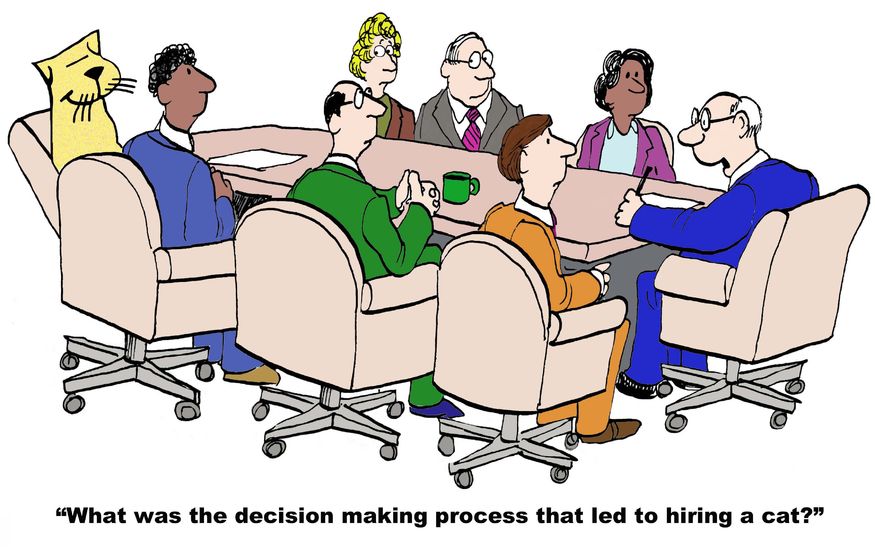One major pitfall in business is group think. It can easily displace independent thinking and good decision-making. I remember being in a strategy meeting with an executive team. We were doing scenario planning for their AI product. I was a fan of the product, believing it had applications in both the private and public sector. It had functions that far out-paced anything in the market. The company was young, and while they had clients –enough to have landed fairly significant seed funding—they were not well-known or strategically diversified.
My role was as a strategy consultant and executive coach. So, I was focused on ensuring that the conversation led to the development of a testable, executable strategy, based in reality — not hope or hype.
The CEO proposed a very optimistic scenario about how the growth trajectory would look if the company expanded into the public sector market, especially city governments.
The Vice President of Sales, charged with leading the penetration of markets, chimed in with his own, equally rosy projections, including numerous examples of opportunities he saw within specific cities for a variety of services. Pretty soon, the entire team was suggesting potential “prospects”, possible new features and myriad use cases for cities.
Let’s look at some of the facts that were true and that everyone in the room was aware of:
• To that point, the company had NO contracts with any government entities.
• The company and employees had NO experience selling to the public sector.
• The product had not been assessed for systems that typically run in public sector entities.
• The company had done NO market research to determine any potential need that cities might want to solve (beyond their own experience as city-dwellers).
Despite that, no one raised any objections, and no one voiced any skepticism about the rosy outlook or the concept of the initiative. That’s group think, and it’s not unusual. People tend to follow a strong voice, especially one in a leadership role, and even more so when that leader is their boss. That’s the nature of group think, and it’s a huge pitfall that trips up even the smartest teams.
It usually happens in far more subtle ways than this scenario. But whether apparent or nuanced, without a concerted effort, groups will echo each other and a leader’s outlook — even increasing their fervency in an unconscious effort to be supportive or a “team player”. Whether the strategy would have worked or not, jumping into action plans based on this kind of unchallenged group think is problematic.
Why?

Blue sky ideation definitely has a place in business and even in strategic planning. It can give rise to breakthroughs of all kinds, including creating markets and generating new applications of existing products or technologies. But until there has been some research to determine the real probabilities of success, investing time and resources in action plans is foolhardy. Nonetheless, the CEO’s idea had a place in the process, just not as an instant green light plan.
As one of several possible scenarios it could seed an effective strategy. It needed to be unpacked, researched and eventually to win through genuine scrutiny. Given the wave of shared enthusiasm around the table, that kind of critical assessment was not forthcoming without intervention.
There are lots of reasons that a team falls into group think. The most toxic reason is if team members are afraid to oppose the boss. I address the importance of avoiding that kind of culture and starting to fix it in several articles. But what if the team is just swept up in their unconscious desire to please? Then, how can you get the conversation to change and the attendees really to scrutinize the idea and refine it?
One possible vehicle for examining the case is to request counterfactuals. Take the CEO’s proposal as the starting point and create a structure to argue against the idea. One approach is with a “pre-mortem” analysis. The idea is to do an analysis of the idea’s (hypothetical) future failure. To try it, choose a point in the future when the idea will have borne fruit if it succeeds. Ask the group to imagine it’s that month or year and that the initiative or idea has failed. Their job is to figure out how and why failed. This will facilitate the group beginning to imagine scenarios that may unfold and how they could impede success.
Another way to get at the real, critical thinking you need is simply to ask the team to enumerate all the things that could make it fail. Don’t worry if they jump back and forth in time-frame, detail and issue. For example, with the example I presented earlier such ideas as the following might arise:
• The product turns out not to fit typical city infrastructure.
• No city is willing to pilot the product.
• Product development takes too long and someone beats them to market.
• It distracts the company from its core competency, selling to businesses, and it loses both markets.
You can start to see right away that some of these issues, although very general and poorly fleshed out, will immediately suggest next steps. Those next steps may be attainable, like doing research to find out what technology cities really use and how integration would work. Other points are less approachable, like those that are pure predictions and call for speculation. But, these are just what can be imagined with NO knowledge of the public sector market. With experience and research there were many more issues that made this strategic initiative more difficult than the CEO initially imagined. Knowing those challenges allowed for an informed decision.
In this setting, I usually ask the group to suggest additional scenarios to assess. It’s best to have several proposed scenarios before committing to strategy. For each of the scenarios that seems plausible the team should go through the same exercise of imagining ways it would fail. In this case, after several vetted scenarios, the team decided to first expand use cases for their current clients, while researching public sector opportunities.
Pushing a team to generate counterfactuals and to do pre-mortems are two ways to fight group-think, but there are lots of others. When group think flourishes ideas go unexplored and bad ideas linger, using up precious resources.
Never surrender when your team simply accedes the point to you. Always push for opposition and diverse opinion. Your team’s willingness to dissent, and their ability to think independently are critical to the organization’s success, regardless of its longevity or size.
A version of this article appeared at Forbes.com on September 18, 2018






Comments
Pingback: The Case of the Shrinking Executives - Amie Devero